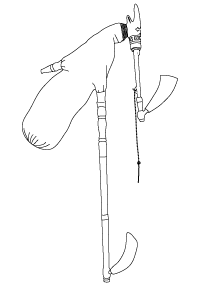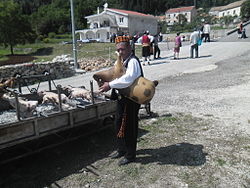
Bagpipes are a woodwind instrument using enclosed reeds fed from a constant reservoir of air in the form of a bag. The Great Highland bagpipes are well known, but people have played bagpipes for centuries throughout large parts of Europe, Northern Africa, Western Asia, around the Persian Gulf and northern parts of South Asia.

The uilleann pipes, sometimes called Irish bagpipes, are the characteristic national bagpipe of Ireland. Earlier known in English as "union pipes", their current name is a partial translation of the Irish language terms píobaí uilleann, from their method of inflation. There is no historical record of the name or use of the term uilleann pipes before the 20th century. It was an invention of Grattan Flood and the name stuck. People mistook the term 'union' to refer to the 1800 Act of Union; however, this is incorrect as Breandán Breathnach points out that a poem published in 1796 uses the term 'union'.

The chanter is the part of the bagpipe upon which the player creates the melody. It consists of a number of finger-holes, and in its simpler forms looks similar to a recorder. On more elaborate bagpipes, such as the Northumbrian bagpipes or the Uilleann pipes, it also may have a number of keys, to increase the instrument's range and/or the number of keys it can play in. Like the rest of the bagpipe, they are often decorated with a variety of substances, including metal (silver/nickel/gold/brass), bone, ivory, or plastic mountings.
The music of Croatia, like the divisions of the country itself, has two major influences: Central European, present in central and northern parts of the country including Slavonia, and Mediterranean, present in coastal regions of Dalmatia and Istria.

Zampogna is a generic term for a number of Italian double chantered bagpipes that can be found as far north as the southern part of the Marche, throughout areas in Abruzzo, Latium, Molise, Basilicata, Campania, Calabria, Apulia and Sicily. The tradition is now mostly associated with Christmas, and the most famous Italian carol, "Tu scendi dalle stelle" is derived from traditional zampogna music. However, there is an ongoing resurgence of the instrument in secular use seen with the increasing number of folk music festivals and folk music ensembles.

The State of Slovenes, Croats and Serbs was a political entity that was constituted in October 1918, at the end of World War I, by Slovenes, Croats and Serbs (Prečani) residing in what were the southernmost parts of the Austro-Hungarian Empire. Although internationally unrecognised, this was the first incarnation of a Yugoslav state founded on the Pan-Slavic ideology. Thirty-three days after it was proclaimed, the state joined the Kingdom of Serbia and the Kingdom of Montenegro to form the Kingdom of Serbs, Croats and Slovenes.
Only Unity Saves the Serbs is a popular motto and slogan in Serbia and among Serbs, often used as a rallying call during times of national crisis and against foreign domination. The phrase is an interpretation of what is taken to be four Cyrillic letters for "S" on the Serbian cross. Popular mythology attributes the motto to Saint Sava, the founder of the Serbian Orthodox Church, however, the true author is Jovan Dragašević.
Balkan music is a type of music found in the Balkan region of southeastern Europe. The music is characterised by complex rhythm. Famous bands in Balkan music include Taraf de Haïdouks, Fanfare Ciocărlia, and No Smoking Orchestra.

Ćevapi or ćevapčići is a grilled dish of minced meat found traditionally in the countries of southeast Europe. It is considered a national dish of Bosnia and Herzegovina and Serbia, with Bosnia and Herzegovina taking steps in branding and placing them on the list of intangible heritage, with a nomination for inclusion on the UNESCO List of Intangible Cultural Heritage. Ćevapi are also common in Albania, Bulgaria, Slovenia, Croatia, Kosovo, Montenegro, North Macedonia and Western Romania.

Vladan Desnica was a Yugoslav writer and translator.

The Hungarian duda is the traditional bagpipe of Hungary. It is an example of a group of bagpipes called Medio-Carparthian bagpipes.

The House of Petrović-Njegoš is the Serbian noble family that ruled Montenegro from 1697 to 1918.

The Istarski mih or Istrian mih is a bagpipe native to the regions of Istria and Kvarner, Croatia.
This article defines a number of terms that are exclusive, or whose meaning is exclusive, to piping and pipers.

Sokolović is a South Slavic surname. It derives from the Slavic word sokol, meaning "falcon" and literally means "son of the falcon". The Sokolović of the Sanjak of Herzegovina were called Sokoli and Sokullu-oğlu, by the Ottomans. One of the coat of arms included in the Korenić-Neorić Armorial (1595) and the Fojnica Armorial (1675–88) claimed to be that of the "Sokolovich". The coat of arms most likely was attributed to the Sokolović of Glasinac.

The Eastern Herzegovinian dialect is the most widespread subdialect of the Shtokavian dialect of Serbo-Croatian, both by territory and the number of speakers. It is the dialectal basis for all modern literary Serbo-Croatian standards: Bosnian, Croatian, Serbian, and Montenegrin.

The Mataruge were a medieval Albanian tribe which originally lived in Old Herzegovina and southern Dalmatia. Their name is attested in historical record for the first time in 1222 in the Pelješac peninsula of Dalmatia. Throughout the 20th century, they were considered to have stopped existing as a separate community during the Ottoman conquest of the Balkans in the 15th century. Modern research in the Ottoman archives showed that they had dispersed throughout the western Balkans following Ottoman conquest and formed settlements in other areas. By 1477, a part of them lived in the kaza of Prijepolje, where they formed their own distinct community (nahiye) with 10 villages (katund). One of their leaders appears in the defter to have been a Vojko Arbanash. Other Mataruga communities had moved in central Croatia and Bosnia. Over time they became culturally integrated in the surrounding communities of their new homelands. Families who trace their origin to the tribe are found today in all countries of the western Balkans.

The Macure were an Albanian tribe that lived on the territory on the part of Montenegro which is today known as Šekular. Bratonožići and Rovci. Like other non-Slavic tribes of Montenegro, they were either assimilated or expelled. The majority of scholars consider them to have been of Albanian origin. Today, their name is preserved in local Serbian legends and myths, while their name is sometimes used in Montenegro as derogative.













